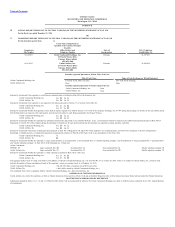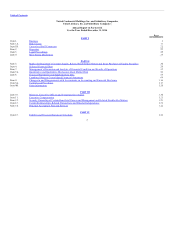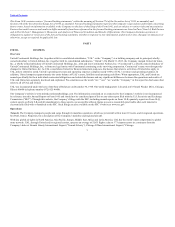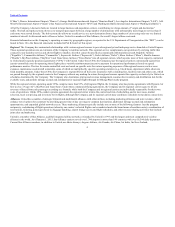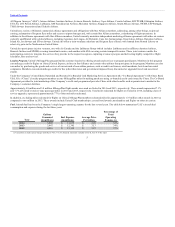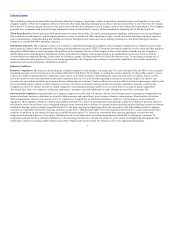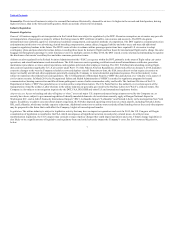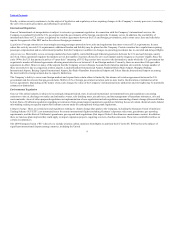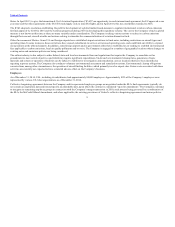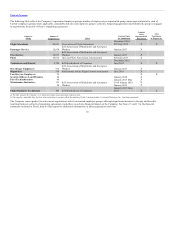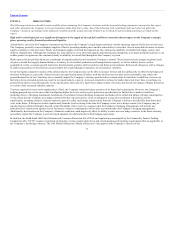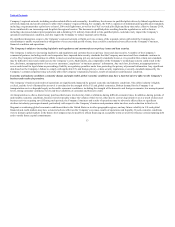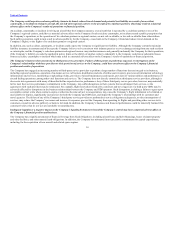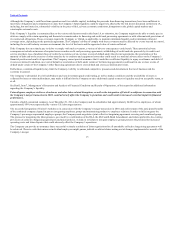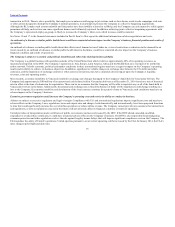United Airlines 2014 Annual Report Download - page 8
Download and view the complete annual report
Please find page 8 of the 2014 United Airlines annual report below. You can navigate through the pages in the report by either clicking on the pages listed below, or by using the keyword search tool below to find specific information within the annual report.
Table of Contents
Finally, aviation security continues to be the subject of legislative and regulatory action, requiring changes to the Company’s security processes, increasing
the cost of its security procedures, and affecting its operations.
International Regulation
International air transportation is subject to extensive government regulation. In connection with the Company’s international services, the
Company is regulated by both the U.S. government and the governments of the foreign countries the Company serves. In addition, the availability of
international routes to U.S. carriers is regulated by aviation agreements between the U.S. and foreign governments, and in some cases, fares and schedules
require the approval of the DOT and/or the relevant foreign governments.
Foreign countries are increasingly enacting passenger protection laws, rules and regulations that meet or exceed U.S. requirements. In cases
where this activity exceeds U.S. requirements, additional burden and liability may be placed on the Company. Certain countries have regulations requiring
passenger compensation and/or enforcement penalties from the Company in addition to changes in operating procedures due to canceled and delayed flights.
Historically, access to foreign markets has been tightly controlled through bilateral agreements between the U.S. and each foreign country
involved. These agreements regulate the markets served, the number of carriers allowed to serve each market and the frequency of carriers’ flights. Since the
early 1990s, the U.S. has pursued a policy of “open skies” (meaning all U.S.-flag carriers have access to the destination), under which the U.S. government has
negotiated a number of bilateral agreements allowing unrestricted access between U.S. and foreign markets. Currently, there are more than 100 open skies
agreements in effect. However, many of the airports that the Company serves in Europe, Asia and Latin America maintain slot controls. A large number of
these are restrictive due to congestion at these airports. London Heathrow International Airport, Frankfurt Rhein-Main Airport, Shanghai Pudong
International Airport, Beijing Capital International Airport, Sao Paulo Guarulhos International Airport and Tokyo Haneda International Airport are among
the most restrictive foreign airports due to capacity limitations.
The Company’s ability to serve some foreign markets and expand into certain others is limited by the absence of aviation agreements between the U.S.
government and the relevant foreign governments. Shifts in U.S. or foreign government aviation policies may lead to the alteration or termination of air
service agreements. Depending on the nature of any such change, the value of the Company’s international route authorities and slot rights may be materially
enhanced or diminished.
Environmental Regulation
The airline industry is subject to increasingly stringent federal, state, local and international environmental laws and regulations concerning
emissions to the air, discharges to surface and subsurface waters, safe drinking water, aircraft noise, and the management of hazardous substances, oils and
waste materials. Areas of either proposed regulations or implementation of new regulations include regulations surrounding climate change (discussed further
below), State of California regulations regarding air emissions from ground support equipment, regulations limiting the use of certain chemicals and a federal
rule-making seeking to regulate airport fuel hydrant systems under the underground storage tank regulations.
There are certain laws and regulations relating to climate change that apply to the Company, including the European Union’s Emissions
Trading Scheme (“EU ETS”), environmental taxes for certain international flights (including Germany’s departure ticket tax), greenhouse gas reporting
requirements, and the State of California’s greenhouse gas cap and trade regulations (that impact United’s San Francisco maintenance center). In addition,
there are land-use planning laws that could apply to airport expansion projects, requiring a review of carbon emissions. These laws could affect airlines in
certain circumstances.
The 2009 European Union (“EU”) directive to include aviation carbon emissions from flights to and from the EU in the EU ETS has been the subject of
significant international dispute among countries, including the United
8

